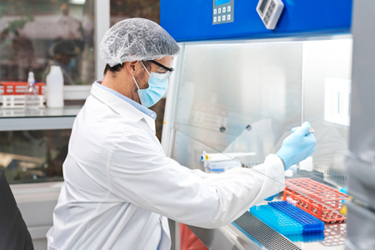Comparing In-house Vs. Outsourced Manufacturing Strategies For CGTs
By Elben Guimaraes, upstream manufacturing expert

As gene and cell therapies rapidly advance, biotechnology companies face the critical challenge of determining the most effective manufacturing strategy. These therapies can potentially cure patients and transform their lives, but they require precise and complex manufacturing processes. Companies must decide whether to build in-house manufacturing capabilities or outsource to CMOs.
The choice is not straightforward and depends on multiple factors such as financial and operational capabilities, stage of the product lifecycle, process modality, and short- and long-term strategies.
A comparative analysis of the advantages of each option can provide valuable insights to guide this decision for cell and gene therapy companies.
In-house Manufacturing Advantages
Control and autonomy
In-house manufacturing gives a company greater control over its manufacturing processes, as well as supply chains and CMC operations, allowing for quicker decision-making and adaptation to process and scheduling changes. This can be particularly crucial for autologous cell therapies processes where production must be tailored to individual patients and the final product cannot be stored for a long time. Flexibility is key when dealing with patient-specific needs, where timelines may shift, and the cold chain must be adaptable to last-minute changes.
Additionally, controlling the manufacturing process internally allows a company to manage risk more appropriate to its needs and priorities, especially during the early phases of a product's life cycle, when competing organizational urgencies might strain resources.
Intellectual property and data collection
Since the manufacturing process is often considered "the product" in cell and gene therapies, keeping production in-house helps safeguard proprietary technologies and minimizes the risk of exposing sensitive intellectual property (IP) and know-how to third parties.
In-house manufacturing also facilitates better data collection from processes and instruments, which can drive continuous process improvement, help resolve issues more efficiently and create opportunities for future IP development. The ability to synchronize and analyze data internally offers an advantage, as the information is readily accessible, helping to refine processes and improve decision-making.
Long-term strategy and cost-effectiveness
In the long term, in-house manufacturing can become cost-effective with accurate demand planning. Investing in a facility that can adapt to a product's life cycle ensures operational longevity and reduces cost as time goes on. If a company employs a platform approach for its cell or gene therapies, the facility can be turned around for multiple products, thereby minimizing capital expenditure for each product.
The same applies for the operational team. Once the operational team is established, cost of operation decreases, especially if the company has multiple products in the pipeline.
Outsourced Manufacturing Advantages
Cost and time efficiency
Outsourcing offers significant cost and time savings, making it an attractive option for small or emerging biotech companies. With CMOs, there's no need to invest in building a manufacturing facility or hiring and training an operations team. This is especially beneficial for startups that need to allocate resources toward R&D or securing further funding, instead of infrastructure. CMOs provide a plug-and-play solution, with ready-to-use facilities, operational teams, and commissioned and validated equipment. This accelerates proof of concept stages, allowing the company to focus on product development and market strategy. This reduces the time required to bring a therapy from clinical trials to commercialization, giving the company a competitive advantage in a fast-moving market.
Expertise and compliance
Some CMOs bring specialized expertise in cell and gene therapy manufacturing, especially in regulatory compliance and global standards. Having phase-appropriate knowledge and experience with the specific therapeutic modalities — such as autologous or allogeneic therapies, viral or LNP delivery systems, CAR-T cells, and gene editing — ensures smooth production transitions during tech transfers, scale-up/out, audits, and each clinical phase.
Again, just as in in-house manufacturing, accurate demand planning is vital when working with a CMO, as changes to timelines might not be possible due to slot availability or costly due to the premium charges to accommodate rescheduling of production.
The Hybrid Approach
Increasingly, companies are opting for a hybrid approach, combining in-house and outsourced manufacturing to gain the best of both worlds. A hybrid strategy provides flexibility by allowing tech transfer between in-house production and CMOs and, most importantly, a backup strategy and options when production schedules don’t go as planned.
In this model, critical and proprietary processes can be processed in-house, while large-scale production or less sensitive steps are outsourced. This dual strategy reduces risk, helps protect IP, and allows for scalability. The hybrid strategy can be considered after initially choosing between in-house or outsourced manufacturing to minimize a massive up-front cost.
Conclusion
Choosing between in-house and outsourced manufacturing is a complex decision that should be guided by the company's resources, timeline, and strategy. While in-house manufacturing offers greater control, IP protection, and flexibility, outsourcing provides cost efficiency, speed, and access to specialized expertise.
For many companies, a hybrid model may offer the best solution, allowing for flexibility and tech transfer between in-house facilities and CMOs. This approach mitigates potential bottlenecks, ensures process control, and positions the company for growth as the demand for cell and gene therapies expands. Although establishing a hybrid model takes time and capital, it can be a long-term goal for companies seeking a sustainable and adaptable manufacturing strategy.
Ultimately, the decision to adopt an in-house, outsourced, or hybrid approach should align with a company's specific needs and vision for growth and success. While each approach will have advantages and challenges during the product life cycle, meeting the ultimate goal of delivering treatment to patients will be worthwhile with any of the approaches.
About The Author:
 Elben Guimaraes is a senior manager of upstream manufacturing at Ultragenyx’s Gene Therapy Manufacturing Facility. With over 15 years of experience in the industry, he was involved in the buildout of multiple sites as well as working at CDMO manufacturing. Connect with him on LinkedIn or email him at elbendantas@gmail.com.
Elben Guimaraes is a senior manager of upstream manufacturing at Ultragenyx’s Gene Therapy Manufacturing Facility. With over 15 years of experience in the industry, he was involved in the buildout of multiple sites as well as working at CDMO manufacturing. Connect with him on LinkedIn or email him at elbendantas@gmail.com.
